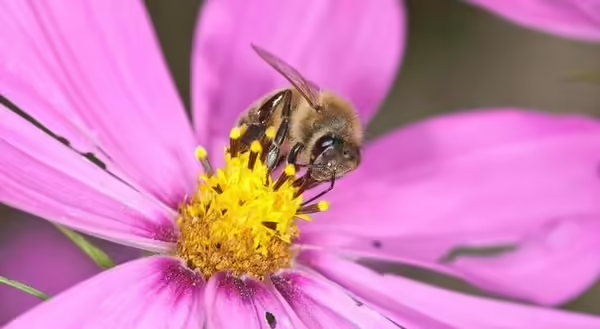
As spring continues to warm up and weeds and insects increase in abundance, demand for management of these populations will continue to grow. Along with pest insects and flowering weeds, bees, wasps, butterflies, and flies will also begin to emerge as essential pollinators in many systems. While managing these other weed and insect pest populations, applicators must protect pollinators during and after pesticide applications throughout the spring and summer. Below are a few ways that applicators can limit the number of residues that will come in contact with pollinators.
Where you spray matters
The simplest way to protect pollinators from pesticides is to avoid spraying where pollinators hang out, namely flowers. Pollinators will spend most of their time foraging by traveling from flower to flower. Some solitary bees, such as squash bees, will spend additional time in flowers as they enjoy napping and sleeping overnight in larger blossoms. When not foraging for food, pollinators like bees and wasps often build or reside in a nest, establish territory, etc., while butterflies and moths often sun themselves on flat surfaces or rest in trees. Therefore, by avoiding spraying flowers or flowing plants, pollinators will encounter significantly fewer pesticide residues, leading to the preservation of pollinators.
Read the label to ensure that other practices are necessary to protect pollinators. While avoiding spraying flowering plants is an excellent rule of thumb, every pesticide is different, and some pose extra restrictions on where they can be applied. The label may state further environmental considerations in the “Precautionary Statements” section under “Environmental Hazards” and/or the “Directions for Use” section under “Endangered Species Protection requirements.” Review both sections before making an application.
Conditions to limit pollinator exposure
Timing and temperature can impact what insects are present during an application. Bees and wasps rely on sight to locate flowers and will not forage before dawn or after dark. Therefore, making applications earlier in the day or later in the afternoon will help avoid some of these pollinators. Most pollinators are also incapable of moving their flight muscles fast enough to fly when temperatures are below 55°F, so applications performed below this temperature will limit exposure to pollinators. Note that the internal temperature of a honeybee hive is often different than outside temperatures, meaning that there may still be low levels of activity directly outside a hive when temperatures are below 55°F.
Problematic formulations and chemistries
Microencapsulated pesticide formulations offer increased safety for applicators but can cause issues for some pollinators. In this formulation, small amounts of concentrated pesticides are encapsulated in plastic or starch, which are then suspended in a carrier. This type of formulation offers a slow release of the pesticide as these capsules break down to increase the residual effects and prevent applications from being directly contaminated with the pesticide if exposure to the formulation occurs. Unfortunately, these microcapsules are similar in size to pollen. If they were to come in contact with a pollinator, they could accidentally get picked up in the pollen sacks or hairs of bees and other pollinators. If a microencapsulated pesticide gets picked up in this nature, the pollinator would be exposed to a higher concentration of that pesticide when compared to other formulations. This issue is further problematic when exposure occurs to social insects such as honeybees, which can pick up that microencapsulation and carry it back to the hive, where the entire hive could come into contact with a concentrated pesticide. When using microencapsulated formulations, applicators must be aware of locations where pollinators might frequent.
A class of insecticides known as neonicotinoids also offer applicators increased safety while creating particular threats to pollinators. Neonicotinoids are designed to mimic the natural insecticidal effects of nicotine with high specificity while significantly decreasing human toxicity compared to plant-produced nicotine; however, the interaction between pesticides in plants creates problems for pollinators. Neonicotinoids are systemic, meaning that when they come in contact with the plant, they are absorbed and carried throughout the plant, allowing neonicotinoids to protect every part of the plant. The downside is that the insecticide will also be expressed in the pollen and nectar, negatively impacting pollinators. Bees are particularly affected by neonicotinoids, with sublethal levels of the pesticide affecting behaviors such as foraging and communication. Limiting the use of neonicotinoids to plants that don’t attract pollinators, waiting till after bloom to apply to plants, or giving flowering plants and gardens a buffer zone can positively impact pollinators.
Protecting honeybee colonies through Fieldwatch
Before performing a large-scale pesticide application, especially in agricultural settings, it is good practice to notify local beekeepers within a 3-mile radius of the application 48 hours beforehand. Doing this can allow beekeepers to protect or move their hives before that application occurs to ensure that their bees are not foraging in the area of the application. To identify beekeepers near you, visit Illinois DriftWatch or FieldWatch, which have mapping tools to locate commercial beekeepers.
Photo credit: honey bee (Apis mellifera), Joseph Berger, Bugwood.org
ABOUT THE AUTHOR: John Schepis provides subject matter expertise and training in pesticide safety with an emphasis on entomology.